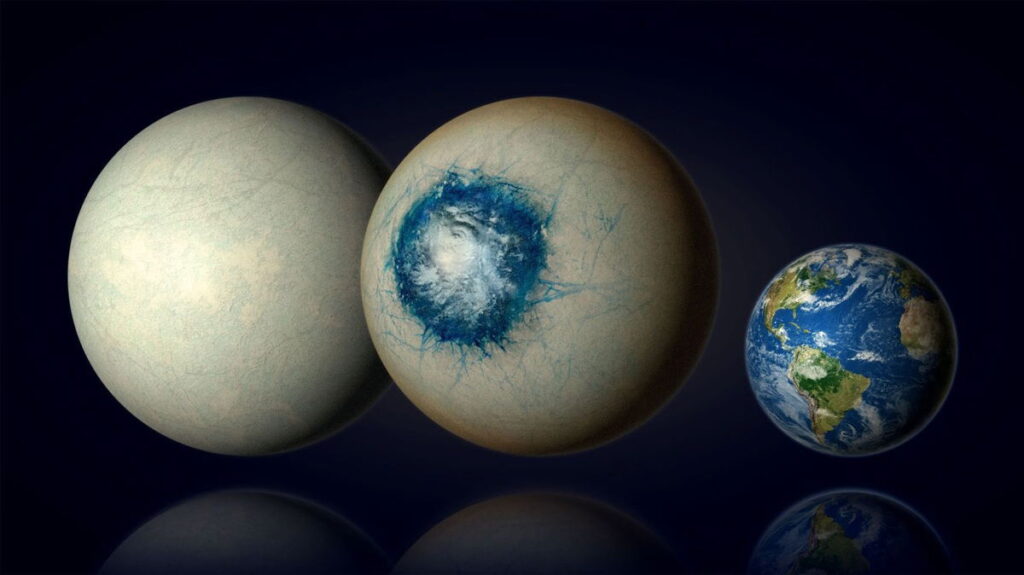
First evidence of an oceanic exoplanet: LHS 1140 b, shown here between an ice world (left) and Earth (right), is 1.7 times bigger than our planet. Thanks to the James Webb Space Telescope, scientists believe it could be either a frozen world or one with a warm ocean and cloudy skies.Credit : x – Visión artística: B. Gougeon.
We all love a good story about distant planets, especially when there’s the faintest glimmer of a chance that something, anything, could be alive out there. Well, the latest buzz in the astronomy world is all about a not-so-catchy-named exoplanet called LHS 1140 b, and trust me, it’s got the experts genuinely excited.
You probably haven’t heard of LHS 1140 b unless you’re already knee-deep in the world of telescopes and space Twitter. But this rocky planet, sitting a “mere” 41 light years away (which, in space terms, is practically next door), might just be the closest thing we’ve found yet to a second Earth. Here’s why it’s causing such a stir.
A Warm ocean and 25-day years: Is this the most Earth-like exoplanet yet?
First off, LHS 1140 b isn’t some frozen wasteland or a giant ball of gas. It’s solid, it’s big (about six times heavier than Earth), and—get this—there’s real evidence it might have an ocean, and not the icy kind either. We’re talking a liquid water ocean with temperatures hovering around 20°C. That’s the sort of water you’d actually fancy dipping your toes in.
Now, before you start packing your bags, there’s a catch. This ocean isn’t spread evenly across the planet. LHS 1140 b orbits close to a faint star, so one side always faces the sun (think “tidally locked”, if you want the science term), and the other side is in permanent darkness. The theory is, all that heat gets trapped on the day side, creating a massive, steamy ‘eyeball’ of water—hence the nickname. It’s the sort of planet that sounds straight out of a sci-fi novel.
And if that wasn’t quirky enough, a year on LHS 1140 b is just 25 days long. Yes, you’d be celebrating New Year’s every few weeks. Birthdays would be chaos.
The hunt for life: Why astronomers are obsessed
Here’s where it gets genuinely interesting. Thanks to the James Webb Space Telescope (you know, the one that keeps delivering jaw-dropping photos), astronomers reckon they’ve found signs of an atmosphere. Not just any old atmosphere, but possibly a nitrogen-rich one, which is basically the starting ingredient for something like what we breathe here on Earth.
That’s no small discovery. Detecting an atmosphere on a planet so far away is a bit like trying to spot a candle flickering in the next town over, during a rainstorm. The fact that Webb might have done it is impressive, to say the least.
Of course, scientists are famously cautious, and nobody’s making wild claims about little green men just yet. But they’re quietly optimistic. Some calculations suggest up to 20% of the planet’s mass could be water, which is more than enough to imagine a lively, if rather soggy, world.
Charles Cadieux, a young scientist from Montreal, even said, “Out of all the exoplanets we know about that could be temperate, this one is our best shot at finding evidence of liquid water.” And as any biologist will tell you, where there’s water, life could be lurking—even if it’s just microbes having a paddle.
Why finding a habitable exoplanet actually matters to us
Now, you might wonder, why should we care what’s going on 41 light years away? The truth is, these discoveries have a way of putting our own little world into perspective. LHS 1140 b isn’t just some distant rock; it’s a reminder that our galaxy is stuffed with surprises. Every planet like this nudges us closer to answering that age-old question: are we alone?
There’s something rather magical about looking up at the night sky and knowing that, on a planet circling a faint star, there could be an ocean shimmering in eternal daylight. Who knows—maybe, just maybe, something is swimming around in there, completely unaware of the fuss it’s causing among Earth’s stargazers.
The hunt continues. Scientists say it’ll take a year or two more of patient observation before we really know what’s happening on LHS 1140 b. But one thing’s certain: the universe just got a little less lonely, and a lot more interesting.
Find more world news






